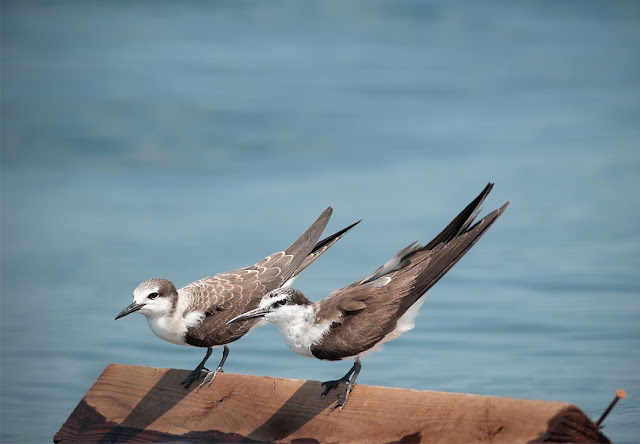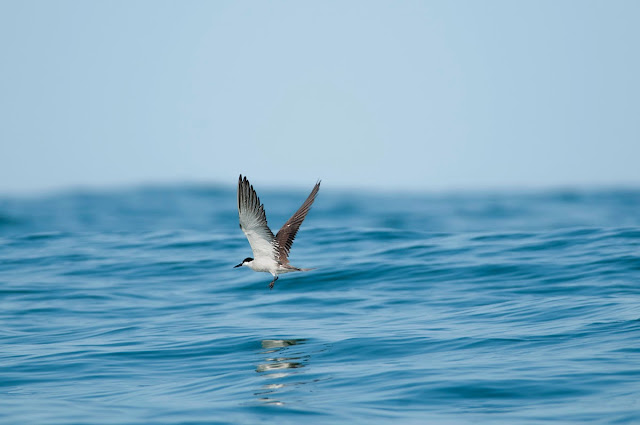It had been more than two years since I did my last pelagic birding, which I would say the most difficult form of birding, at least to me! That was in April of 2011 when I was a part of a group of 16 members and was done off the coast of Kannur, Kerala. You can read more on that in my blog on the same - "Going Pelagic - The Second Innings!"
This time it was off the coast of Nileshwar of Kasaragod district in Kerala. The group was of around
20 members that included some eminent birders from Delhi, Jaipur and Kolkata along with birders from Bangalore and Kerala and that included my wife Sahana as well! :) The trip was organised by MNHS (Malabar Natural History Society).
What was supposed to be an overnight pelagic, which meant spending the night out in the ocean, had reduced into an one day pelagic due to bad weather on the first day (21st Sept, 2013). The disappointment of missing a chance to do my maiden overnight pelagic was somehow compensated by the birding that we did on the first day where we saw some great species - Pectoral Sandpiper, which is the second record for India and a Caspian Plover, which is a first record for Kerala! Thanks to the eminent birders in the group without whom those were quite hard to even identify, let alone spotting in the crowd of hundreds of sand plovers! On the same day we had seen a dead bird that was recovered by fishermen and that turned out to be Cory's Shearwater, which was the first record from South Asia!
 Pectoral Sandpiper
Pectoral Sandpiper
After the rainy first day, our hopes went high as the sky was becoming clear and everything looked good for the pelagic the next day.
We hit the waters at around 7:00 in the morning. Because we couldn't get a bigger boat we had to contend with two boats and the team was split into two. These boats were small fishing boats and were much smaller than the one in which I went last time. This meant we couldn't go quite far and we were targeting somewhere around 20 - 25kms from the coastline.
The usual sights of Bridled Terns started soon after we crossed the turbulence zone and we started looking for the true pelagic species like the Shearwaters, Skuas and Petrels etc.
The sky was clear and as we went almost 7 - 8kms off the coast we saw our first sighting of Flesh Footed Shearwater, a lifer to me! Later we found out that the region was quite dominated by their number and we saw close to 200 birds in total in the whole duration of our birding!
Another interesting specie for me was Streaked Shearwater. There were 3 -4 individuals in the group of tens of Flesh Footed Shearwaters and at one group we even saw 6 of them!
I had not seen any Storm Petrels in my last pelagic and I was quite eager to see one. I was not disappointed as we spotted two types of Storm Petrels - Wilson's Storm Petrel and Swinhoe's Storm Petrel!
As we were discussing the absence of any Skuas we just got a glimpse of an Arctic Skua and later we went quite close to it to have a better look. I had seen them in my last trip and had enjoyed their acrobat and combating with Greater Crested Terns!
There were several Bridled Terns all over and while coming back we saw some Roseate Terns in breeding plumage!
On our way back a Catharacta Skua caught our interest. Unfortunately it was flying quite far and the images that we got were not conclusive enough to make out if it were a South Polar Skua or a Brown Skua.
We were back on the land by around 1:30pm and the whole group was exhausted. Many in our team had suffered from sea sickness in spite of taking medication to prevent it. They were all happy after they landed their feet on the land! :)
 All in all it was a very nice trip and hoping to do the next Pelagic and next time it would be an overnight one!
All in all it was a very nice trip and hoping to do the next Pelagic and next time it would be an overnight one!
Hoping to see the sea at night next time!
Cheers,
Ash
Flesh Footed Shearwater
This time it was off the coast of Nileshwar of Kasaragod district in Kerala. The group was of around
20 members that included some eminent birders from Delhi, Jaipur and Kolkata along with birders from Bangalore and Kerala and that included my wife Sahana as well! :) The trip was organised by MNHS (Malabar Natural History Society).
What was supposed to be an overnight pelagic, which meant spending the night out in the ocean, had reduced into an one day pelagic due to bad weather on the first day (21st Sept, 2013). The disappointment of missing a chance to do my maiden overnight pelagic was somehow compensated by the birding that we did on the first day where we saw some great species - Pectoral Sandpiper, which is the second record for India and a Caspian Plover, which is a first record for Kerala! Thanks to the eminent birders in the group without whom those were quite hard to even identify, let alone spotting in the crowd of hundreds of sand plovers! On the same day we had seen a dead bird that was recovered by fishermen and that turned out to be Cory's Shearwater, which was the first record from South Asia!
 Pectoral Sandpiper
Pectoral Sandpiper
Record shot of a Caspian Plover
After the rainy first day, our hopes went high as the sky was becoming clear and everything looked good for the pelagic the next day.
Flesh Footed Shearwater shearing the water surface
We hit the waters at around 7:00 in the morning. Because we couldn't get a bigger boat we had to contend with two boats and the team was split into two. These boats were small fishing boats and were much smaller than the one in which I went last time. This meant we couldn't go quite far and we were targeting somewhere around 20 - 25kms from the coastline.
Bridled Terns
Bridled Tern
Bridled Tern
Bridled Terns
The usual sights of Bridled Terns started soon after we crossed the turbulence zone and we started looking for the true pelagic species like the Shearwaters, Skuas and Petrels etc.
Flesh Footed Shearwater
Flesh Footed Shearwater
Flesh Footed Shearwater.
See the color of the foot, that is where the name is from.
Another interesting specie for me was Streaked Shearwater. There were 3 -4 individuals in the group of tens of Flesh Footed Shearwaters and at one group we even saw 6 of them!
Streaked Shearwater (the whitish bird) in the group of Flesh Footed Shearwater
A wider view of the group. Image by Sahana.
A closer look of the Streaked Shearwater in flight
A larger flock containing Flesh Footed and Streaked Shearwaters
A record shot of Swinhoe's Storm Petrel
A record shot of Wilson's Storm Petrel
As we were discussing the absence of any Skuas we just got a glimpse of an Arctic Skua and later we went quite close to it to have a better look. I had seen them in my last trip and had enjoyed their acrobat and combating with Greater Crested Terns!
Roseate Tern, the one with the orangish red beak
On our way back a Catharacta Skua caught our interest. Unfortunately it was flying quite far and the images that we got were not conclusive enough to make out if it were a South Polar Skua or a Brown Skua.
We were back on the land by around 1:30pm and the whole group was exhausted. Many in our team had suffered from sea sickness in spite of taking medication to prevent it. They were all happy after they landed their feet on the land! :)
 All in all it was a very nice trip and hoping to do the next Pelagic and next time it would be an overnight one!
All in all it was a very nice trip and hoping to do the next Pelagic and next time it would be an overnight one!
The Theme of Pelagic
Hoping to see the sea at night next time!
Cheers,
Ash





















4 comments:
Good to see your post after a long time. Keep them coming.
Thanks,
Anoop
All snaps are lively and lovely...!
So... Ashwini is back with a bang of birds...!
need to do one, been hearing a lot :)
Post a Comment